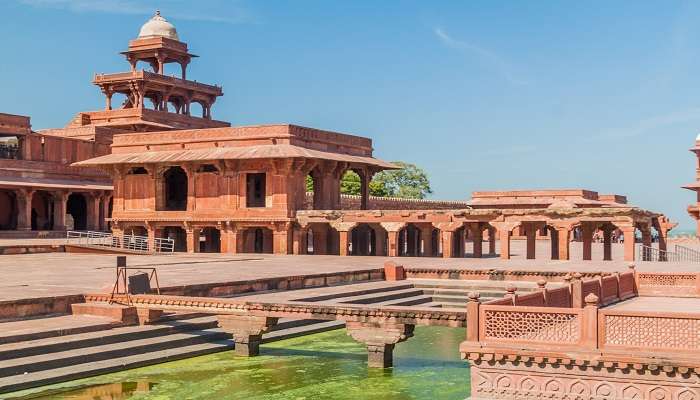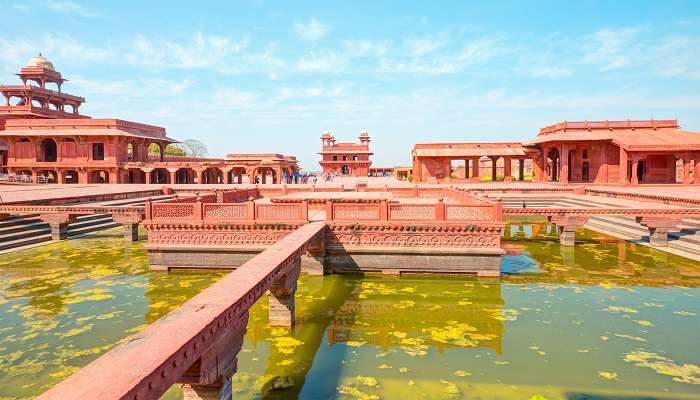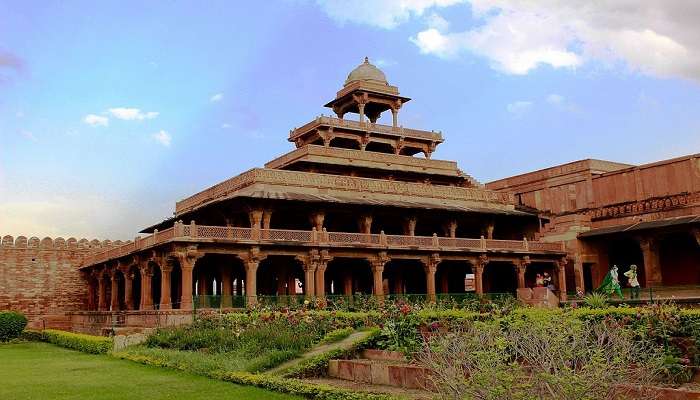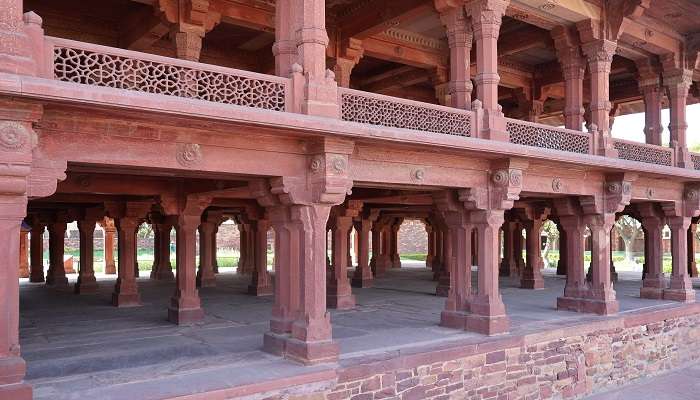Visit Panch Mahal For An Exotic Holiday Destination In Agra 2026

The Panch Mahal is a five-story structure located in Fatehpur Sikri, in the Indian city of Agra. The architectural marvel is a part of many iconic structures built by Emperor Akbar in the town of Fatehpur Sikri during the late 16th century. The iconic palace of Panch Mahal, built of red sandstone, is a confluence of Mughal, Islamic, and Classic Indian architecture. Adorned with intricately carved pillars, walls, and latticework, This Mahal of Fatehpur Sikri is a wonder that attracts tourists for its beauty and royal legacy. Witness and marvel at this ancient architectural beauty that exudes royalty and allure, which attracts tourists from across the world.
History Of Panch Mahal In Fatehpur Sikri

The Panch Mahal in Fatehpur Sikri is a five-story palace built by Emperor Akbar in the small town of Fatehpur Sikri near Agra. Constructed in the 16th century, the palace is an architectural wonder that catches the attention of tourists visiting Fatehpur Sikri. The history of Panch Mahal has its roots in the short-lived capital of Fatehpur Sikri under the reign of Emperor Akbar.The construction of Fatehpur Sikri, along with the Mahal, began in 1571, and it took 15 long years for the city to be adorned with beautiful palaces, mosques, royal houses, administrative buildings, temples, and living quarters. Now, a UNESCO World Heritage Site, Fatehpur Sikri is a renowned Tourist attraction and sees a large number of tourists throughout the year.
The exact purpose of the construction of the Panch Mahal is not known. It is believed that the five-story building was designed as a relaxation and entertainment spot for the families of the royal houses. The palace provides panoramic views of the entire town of Fatehpur Sikri and was an amusement spot for the Emperor. This Mahal also served as a space for the royal women of the Mughal Empire.
Must Read: Holi In Mathura
The Architecture

The architecture of the Panch Mahal witnesses a confluence of Islamic, Indian, and Mughal construction designs. The overall structure of the Mahal reflects a pyramidal shape. Each palace floor is gradually smaller than the one below it, giving it a pyramidical appearance. Built entirely of red sandstone, the Panch Mahal is designed as an open pavilion. Proper ventilation creates an open, airy, and breezy atmosphere for the royal families to converse and relax. The palace’s aesthetic appeal is a sight to behold for travellers and wanderlusters.
Each floor of the Palace is designed in a unique way, giving it a pleasing and distinctive appeal. Out of the five floors, the ground floor is the largest and comprises 84 pillars that support the other floors of the palace and create a large and expansive space for proper airflow and maximum ventilation. The other floors are also designed similarly, with each floor gradually smaller than the ones below it and a decreasing number of pillars from the one below it. As one progresses, the floors of the Mahal offer scenic views of the landscapes and the lush green surroundings around it. The fifth and topmost floor is the smallest, with an intricately carved dome or Chhatri at the centre. This floor provides a panoramic view of the surroundings and is the prime spot for relaxation and observation. The detailed architectural study of the Panch Mahal provides us with a glimpse of intricately carved pillars and walls with floral motifs and geometric figures that symbolise the Persian style of architecture. The open pavilions are adorned with exquisite Jaali or Latticework, which is a symbol of Mughal architecture. These jaalis provide shade and allow for airflow, all while giving a distinctive and aesthetic appeal to the Mahal.
Significance Of the Panch Mahal

The open design of the Panch Mahal, with its numerous Jaalis, Jharokhas, and columns, was intended to create a natural ventilation and cooling effect amidst the hot weather conditions of North India. With 176 pavilions, the Panch Mahal was a one-of-a-kind structure that has stood out with time.
The detailed design elements and intricate carvings at the Panch Mahal made it a perfect spot of recreation, relaxation, and amusement for the Emperor and his royal family. The innovative design, perfect architecture, and the blend of Indian and Islamic designs make Panch Mahal an architectural marvel for tourists and historians. The intricately carved floors adorned with floral and Islamic motifs, and open pavilions with emphasis on ventilation and airflow are hallmarks of the craftsmanship and architectural creativity of the artisans of the Mughal era.
Suggested Read: Agra Fort
Things To Know Before Visiting The Mahal

The Panch Mahal is a five-story structure built by the Mughal Emperor Akbar in the 16th century. Located 1 km from the Fatehpur Sikri railway station, it was built as a summer retreat for the emperor and his royal court. Just in front of the Mahal complex is a pool known as Anoop Talao. The pool was filled with water and served as a venue for musical performances during Akbar’s reign.
Entry Fees- INR 20 to INR 260
Timings- 7 am to 6 pm. (Everyday, except Friday)
Further Read: Soulful Retreats Near Agra
Now that you have a complete guide to Panch Mahal and a list of things to keep in mind for your next vacation to Fatehpur Sikri to visit this remarkable structure, go ahead and plan your trip to Agra and visit this architectural marvel that captivates the hearts of tourists. Indulge in the exotic views and capture some breathtaking images to cherish forever.
For our editorial codes of conduct and copyright disclaimer, please click here.
Cover Image Source: Shutterstock
Frequently Asked Questions About Panch Mahal
Which is the nearest airport to Panch Mahal?
The Kheria airport in Agra is the nearest airport to Fatehpur Sikri and the architectural marvel of Panch Mahal, Situated at a distance of 40 km from the Panch Mahal complex.
Which is the best time to visit Panch Mahal in Fatehpur Sikri?
The best time to visit Panch Mahal is during the winter months. For the best sightseeing, visit the town from October to February, when the weather is cold and pleasant for a comfortable excursion.
What are some affordable accommodations near Panch Mahal in Fatehpur Sikri?
Here are some of the best accommodations that offer a budget-friendly and comfortable stay to its guests.
- Hotel Govardhan Tourist Complex
- Hotel Vrindavan
- The Grand Barso( A luxury heritage)
- Iora Guest House
What are some nearby attractions to Panch Mahal?
The Panch Mahal complex is located in the town of Fatehpur Sikri. The town is home to many other stunning structures such as Buland Darwaza, Jodha Bai’s Palace, Jama Masjid, Hiran Minar, Keoladeo Bird Sanctuary. The famous Agra Fort, Taj Mahal
How much time is required to cover the Panch Mahal and nearby spots of Fatehpur Sikri?
Panch Mahal and other nearby attractions of Fatehpur Sikri can be covered in a span of 2-3 days.
Why should on visit Panch Mahal?
Panch Mahal is an iconic palace built by Emperor Akbar in the 16th century. The grandeur of the fort and its remarkable design make it a must-visit spot for travellers and tourists.
People Also Read:
Hawa Mahal Taj Mahal Rang Mahal

As a Travel Content Writer, I live to conquer the world of globetrotting with words. With my unquenchable thirst for storytelling, I believe that my words will inspire you to travel around the world’s breathtaking landscapes. As for me, I am an unapologetic selenophile, who loves to wander around in a starry night!











